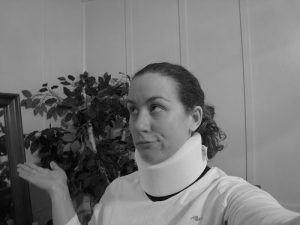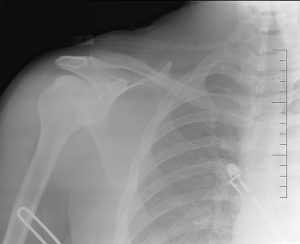What is Chiropractic Treatment of Whiplash?
To download a copy of this week’s newsletter, please click here.
Clear Lake City Chiropractor Comments: Whiplash is basically an injury to the muscles, the muscle attachments (tendons), ligaments, and sometimes the nerves that exit the cervical spine. The degree of injury is highly variable and depends on many factors, some of which include gender/body size (slender woman are especially at risk), awareness of the impending collision, head position at time of impact, the angle of the seat back (bent back is worse that upright), the position of the headrest (too low is common), the amount of vehicle damage (less damage can be worse due to energy transferred to the contents/occupants), the speed of the collision, and many others.

Therefore, when discussing the treatment approaches used by chiropractors, it is not appropriate to generalize since each case is so unique. With that said, when a whiplash patient visits a chiropractor, the first step is obtaining as much information as possible. A thorough history and examination are important in determining the treatment plan and help to determine severity of the injury. Chiropractors often offer different types of treatment that may include: manipulation, physical therapy modalities such as muscle stimulation, relaxation, ultrasound, low level laser therapy, cervical traction, and others. Spinal manipulation (often referred to as an adjustment) addresses joint dysfunction and can be performed with one of several approaches. The first and quite common approach uses a high velocity, low amplitude (quick) approach where joint cavitation (the “crack”) often occurs. Another approach is a low velocity, low amplitude technique where mobilization is used, which is more of a stretch to the end-range of intersegmental (between the vertebrae) motion and rarely, is there joint noise/cavitation.
Muscle relaxation or stimulation is performed for muscle dysfunction, which may include relaxation or stimulation techniques. Gentle stretches to a muscle that has excessive tightness or, repeated contractions of a weak (“inhibited”) muscle is also commonly utilized and very helpful when muscle dysfunction is present.
Exercises are frequently prescribed by chiropractors. These are taught in a supervised manner and when it is safely performed and understood, they can be performed at home, work, outside the office setting. It may require a few sessions to ensure accuracy of the exercise performance. Because of muscle spasm, joint dysfunction, and pain, patients often develop faulty postures or compromised movements that become “bad habits.” To break these “bad habit” positions/postures, stabilization and sensory-motor retraining exercises can be very helpful. These exercises retrain the nervous system to achieve better coordination and control movements and to maintain stability of the weakened neck muscles.
Advice on bend/lift/pull/push and/or work related activity is extremely important in order to avoid repeat exacerbations or “flare-ups” if not properly dwelt within the clinic. Advice on recreational and home related activities is also very important for the same reasons.
The chiropractic whiplash treatment plan is unique for every individual person given the significant number of variable initially discussed. One or more of the approaches discussed may be utilized. If needed, chiropractors often partner with other doctors if there are medication or surgical requirements. If you, a loved one, or a friend is struggling with whiplash residuals from a motor vehicle collision, you can depend on receiving a multi-dimensional chiropractic assessment and therapeutic approach at this office. We sincerely appreciate your confidence in choosing our office for your health care needs!
Dr. Ward Beecher practices at Beecher Chiropractic Clinic at 1001 Pineloch, Ste 700 Houston, TX 77062. You can schedule an appointment with the best chiroprator in Houston or by calling (281) 286-1300. If you have any questions regarding this blog, please comment below!
Top 5 Chiropractic Myths
Clear Lake Chiropractor Comments: In the 28 years that I have been a chiropractor, I have been consistently surprised by some of the myths about chiropractic and chiropractors that still persist today. Here are the ones that I hear the most.
- Adjustments hurt: When someone is experiencing back pain the last thing they want to experience is worsened pain in the chiropractor’s office. If your chiropractor is performing an adjustment correctly, it should not be painful. Though there might be some brief discomfort, this has to do with your presenting injury and not the adjustment itself. Generally, patients feel relieved and comfortable after an adjustment. Any soreness noted should be similar to what you feel after too much yard work or working out at the gym.
- Once you start you have to keep going: Everyone is afraid of making commitments, especially financial ones, and no one wants to hear that once they see a chiropractor they will have to go for the rest of their lives. The chiropractor will develop a specific treatment plan after identifying what is causing your pain. This plan includes the number of sessions the chiropractor believes you will need to complete the care and improve your symptoms. Some patients will see a chiropractor for conservative maintenance, in the same way you would eat healthy foods or exercise, the choice to continue going is up to you.
- Chiropractic Care is Dangerous: Chiropractic care is inaccurately believed to be more dangerous than standard medical care. Chiropractic care is less invasive than other medical interventions that increase risk for injury. Surgery and medical side effects are more dangerous than any of the non-invasive methods that chiropractors prescribe, like a neck manipulation or spinal adjustment. The American Chiropractic Association has compiled information about risk of death from spine surgery, neck surgery, and taking non-steroidal anti-inflammatory drugs and aspirin, all of which have a much higher risk of serious side effects and death.
- Chiropractors aren’t REAL doctors: Most people are aware of the delicate nature of necks and spines, and therefore only want to entrust their care to a doctor that is properly accredited. Generally, chiropractors have four years of pre-medical undergraduate education, learning about various scientific fields. Next, they have to complete 10 trimesters or about 4 years of study at an accredited chiropractic college. During these years, students must complete approximately 4,800 hours of study, combining time in the classroom and laboratory and clinical experience. This breadth of education prepares chiropractors to treat the variety of cases they see.
- Cracking your back yourself is the same thing: This falsehood is particularly frustrating considering the above information about the advanced training each chiropractor has to receive to be able to practice. This training enables chiropractors to have an understanding of the sensitive nature of joints and how they function. People also incorrectly assume that it is the same thing when their massage therapist, coach or physical therapist performs it, it isn’t. Just because you hear a noise when you crack your back at home does not mean you have achieved the same results as a carefully orchestrated spinal adjustment in the chiropractor’s office.

68669_2835 flickr photo by DrDawn1 shared under a Creative Commons (BY-SA) license
Dr. Ward Beecher practices at Beecher Chiropractic Clinic at 1001 Pineloch, Ste 700 Houston, TX 77062. You can schedule an appointment at his Houston chiropractic clinic by calling (281) 286-1300. If you have any questions regarding this blog, please comment below!
Pain Between Your Shoulders?
To download a copy of this week’s newsletter, please click here.
Houston Area Chiropractor Comments: Patients come into the office complaining of burning pain in their upper back or stabbing pain between their shoulders. Pain in the upper and/or mid back is less common than lower back pain or neck pain in Houston. The upper back is the area between the cervical spine (neck) and the low back (lumbar spine). The upper back is called the thoracic spine, and it is the most stable part of the spine. The range of motion in the upper back is limited because of the spine’s attachments to the ribs (rib cage). This stability plays an important role in holding the body upright and providing protection for the vital organs in the chest.

The primary causes of thoracic pain are muscular problems, joint dysfunction, herniated or degenerative discs, arthritis, vertebral fractures, kyphosis (hunchback) or scoliosis. Muscular problems are the most common and are typically related to poor posture or being in the same posture for prolonged periods of time (ie. on a computer or having large breasts). Joint dysfunction is typically related to spinal subluxations or irritation where the ribs attach to the spine. Degenerated or herniated discs in the thoracic spine are not as common as the cervical or lumbar spine, but can cause pain also. Arthritic changes increase as the person ages. The arthritis can cause aggravation of the joints or irritation of the nerves. Vertebral fractures can either come from compression fractures in people with osteoporosis or from accidents or injuries. Kyphosis (hunchback) can be due to Scheuermann’s kyphosis, ankylosing spondylitis (AS) or simply poor posture. Scoliosis is a sideways curvature of the spine.
Thoracic pain can also be due to secondary causes. Some of the secondary causes of mid back pain are bone cancer, shingles, stomach ulcers, problems affecting the lung (including a Pancoast tumor), stomach, liver, gallbladder and pancreas problems can all cause referred pain in the thoracic spine area.
The key to getting pain free is a proper history and exam so that the correct diagnosis is made. Here at Beecher Chiropractic we have seen hundreds of cases of mid back pain over the last 26 years. We will be able to determine if you simply need to modify your workstation, do you need chiropractic care and/or rehabilitative exercises or do you need to be referred to another provider. Your health is our primary concern.
Dr. Ward Beecher practices at Beecher Chiropractic Clinic at 1001 Pineloch, Ste 700 Houston, TX 77062. You can schedule an appointment at BeecherChiropractic.com or by calling (281) 286-1300. If you have any questions regarding this blog, please comment below!


